January 14th brought together one of the most fascinating encounters of the Premier League season. Man City, in the midst of an undefeated season, faced up against an in form Liverpool team in the middle of their own 17 game unbeaten run. The reverse fixture had resulted in a 5-0 resounding victory for the Citizens, and Liverpool were surely determined to seek revenge.
Alongside this fascinating narrative was the intriguing tactical battle that would take place between two of the top managers in the world. Both Guardiola and Klopp are famed for their attacking style and the spectacle of two quality offensive sides going toe-to-toe didn’t disappoint. The key question was always going to be how City’s possession-domination approach would collide with Liverpool’s high energy aggressive style.
The match of course ended 4-3 to Liverpool and ended City’s hopes of an undefeated season. Despite this close scoreline, the reality was that Manchester City struggled to compete in the game. Their possession based style was severely disrupted by Liverpool’s high press and they were unable to push themselves into dangerous areas and create decent chances. City ended the game having posted their lowest shots total of the season. The two consolation goals at the end flattered the away side.
But just how did Liverpool do what no Premier League team had managed to do all season and defeat Manchester City?
‘Out of this planet’ Pressing’
Liverpool lined up in their usual fluid 4-3-3 formation, but cycled through several defensive formations Inez order to control the space within which City played. Manchester City lined up in a similar fashion in their typical 4-3-3, with Fernandinho playing as the sole pivot (or ‘6’), with Gundogan and De Bruyne operating as dual 8’s in front of him, forming a 1-2 triangle in the centre of midfield. With both teams using the same shape you might expect the strategies of both sides to be similar. This, however, was not the case, as both managers utilised their formations very differently.
Guardiola used his 4-3-3 and ‘1-2’ midfield to facilitate his build up play. By playing two midfielders ahead of his 6, he planned to make it easier for his side to break through Liverpool’s press as their vertical passing lanes from the back were maximised. Liverpool used their formation much more fluidly and more in a defensive manner by flexing between 4-3-3, 4-5-1 and 4-2-3-1 dependent on the situational position of the ball and using their 6 in a much more advanced role. It was a very clear tactical choice by Klopp as it allowed his team to sit behind the ball and limit the attacking spaces City, and in particular De Bruyne were used to operating within. Simultaneously, Liverpool were able to leave enough players up front to attack City’s backline with their aggressive press.
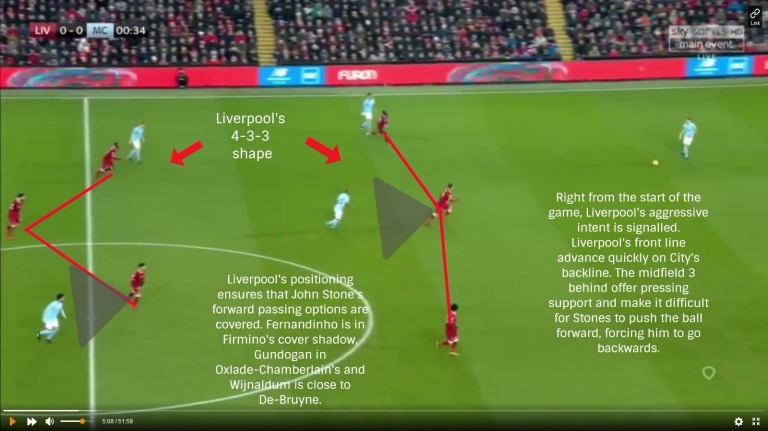
Liverpool’s plan was obvious. Limit the amount of time the City defenders had on the ball. By pressing the back line, Liverpool were targeting the weaker ball players in City’s team and restricting the available passing options they had open to them. This forced them into either playing risky vertical passes to feet in their own half or into pushing the ball forward aerially, where Liverpool’s tall defenders would hope to compete with the Citizens’ smaller forward line.
In the immediate aftermath to the game, Klopp described his sides pressing as ‘out of this planet’ and it was exactly this high quality execution of his tactical choices that unsettled City’s build up play from deeper positions and allowed Liverpool to overwhelm City and create the chances they needed to win the game.
Pressing Traps
A key to understanding just how much Manchester City struggled is to focus on their patterns of play in their build-up. Often, the centre backs will split, Fernandinho will drop and the full backs will push up to create a 3-4-3 shape. This shape is optimal for a possession orientated side as it creates positional triangles all over the pitch, putting players in natural support positions and making it easier to recycle the ball and thus advance up the pitch. The ‘1-2’ triangle is also a common shape for a Guardiola side as the build up is further aided by the 6 having more vertical passes in front of him. However, this tactical choice was exploited by Liverpool very effectively. The home side disrupted City’s build up play by isolating Fernandinho in possession and springing pressing traps in order to turn over the ball high up the pitch and launch quick counter attacks against City’s isolated back line.
Liverpool attempted this pressing trap all throughout the game and it proved to be a very useful strategy as it not only provided Liverpool with several counter attacking opportunities but was also the key to unlocking City’s defence.
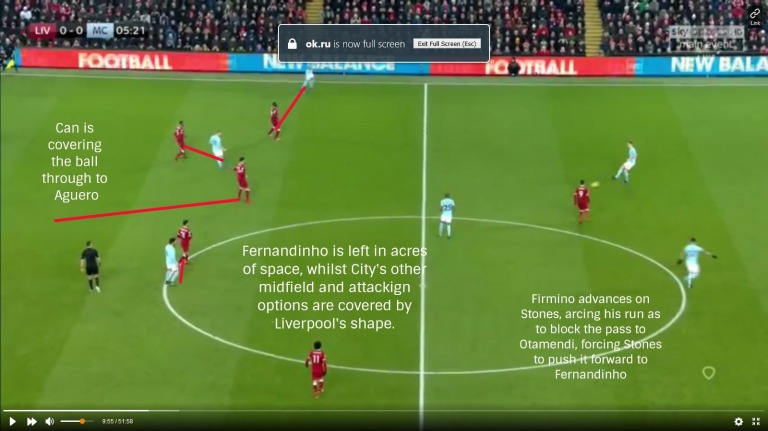
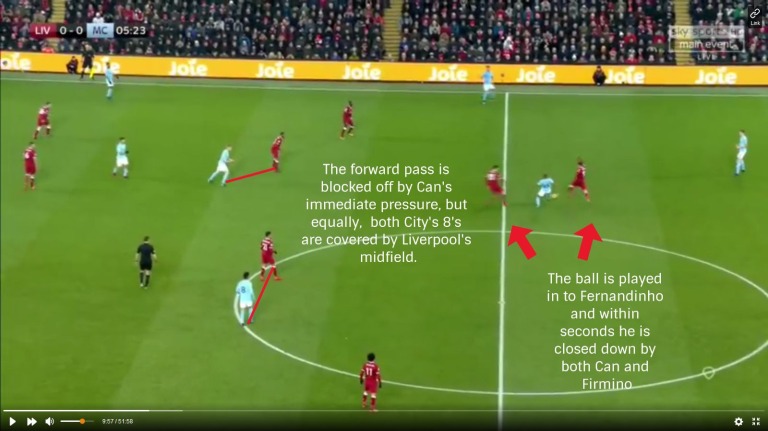
Fernandinho eventually squeezed the ball back to Stones, and the trap was unsuccessful on this occasion, but there are numerous examples of this tactic being employed throughout the game by Liverpool and was a clear plan designed by Klopp to disrupt City’s build up and win the ball back high up the pitch.
This tactic eventually reaped the rewards for Liverpool. In the space of the 30 seconds surrounding Liverpool’s second goal, Liverpool had trapped Fernandinho twice, forcing him into errors resulting in Mane hitting the post and eventually scoring a wonderfully hit strike for Liverpool’s third.
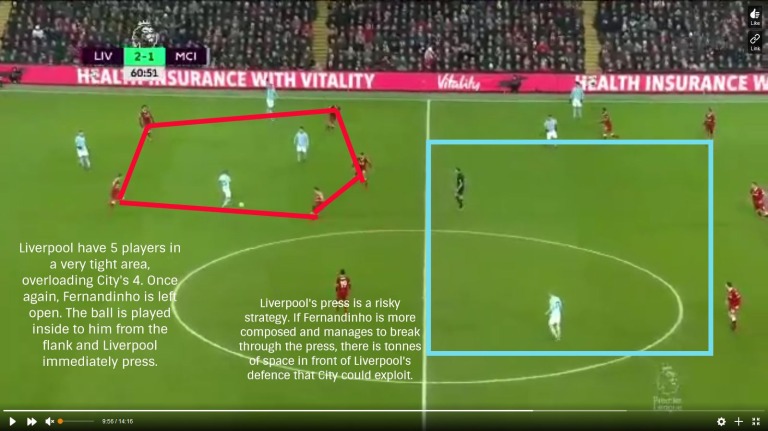
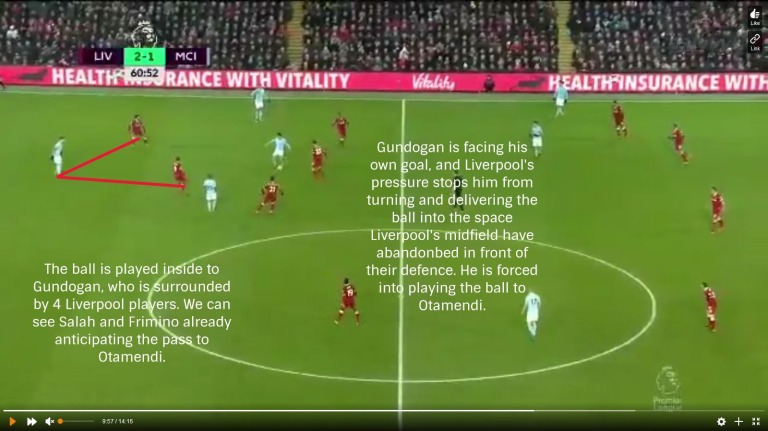
As Otamendi receives the ball, he is already under immense pressure from Salah, and his attempted clearance is blocked. Liverpool recover the loose ball, attack City’s broken lines, and score the third goal from this turnover of possession.
We can see the clear advantages that Liverpool’s more fluid 4-3-3 offered them. Nominally, Can played as the 6, a role usually played horizontally across the pitch in front of his teams defensive line. This is how Fernandinho, as Guardiola’s 6 interprets the role. However, Klopp used the position in a much more vertical and less traditional style by allowing his 6 to advance up the pitch and act as the most forward midfielder in Liverpool’s press. Can consistently and aggressively closed down Fernandinho and initiated the pressing trap. This is typical of Klopp who seems to have a preference for midfielders that do play in this more vertical fashion in order to break opposing midfield lines. By advancing his 6 so far up the pitch, Liverpool were taking a risk. If City bypassed the press, the space in front of Liverpool’s defence was there to be exploited. However, because of their smart press and positional play, coupled with Fernandinho’s limited ability to advance the ball under pressure, City were rarely able to exploit this space and hurt Liverpool in any meaningful manner.
From City’s perspective, we can note the immediate disadvantage of the ‘1-2’ triangle interpretation of the 4-3-3. With a strategy involving pressing and isolating the deep lying midfielder (the 6), and with all your passing options ahead of the ball, any turnovers leave your backline exposed. This strategy was used to exceptional effect by Liverpool. This particular pressing trap was attempted several times throughout the match, resulting in numerous turnovers and counter opportunities. With Liverpool’s potent front 3, it was only a matter of time before City were going to be punished.
Build Up
Another interesting dynamic of the game was how Liverpool would cope with being out-possessed by their opponents. Liverpool are usually the team that dominates the ball, clocking up an average possession of 57%. This is not necessarily a preference by Klopp, but rather a tactical choice by opposing sides to minimise Liverpool’s counter-pressing prowess. I have discussed this in depth in another article.
Klopp, however, was clearly not worried about this as he allowed City to dominate and control the ball in their midfield and defensive areas. Given’s City’s technical advantage over Liverpool is this area, this was a wise decision, though it obviously came fraught with inherent risks. Liverpool managed just 36% of the ball, their second lowest possession rate of the season (the lowest being in the reverse fixture where Liverpool were reduced to ten men). There were two principle reasons Klopp was satisfied with seeing so little of the ball. Firstly, Liverpool knew that pressing throughout the game was unrealistic, as maintaining that intensity would result in fatigue which would be exploited by City later in the game, a prominent feature of the league leaders’ season. Guardiola’s team have made a habit of scoring several late goals against tired opponents who have been chasing the ball for large periods of the game. There were very deliberate stretches of the game where Liverpool consolidated and fell back into a 4-5-1 shape, restricting City’s forward passing options, and allowing them to recycle the ball in low risk areas.
The second reason for the possession disparity was a result of what Liverpool tried to do when they actually had the ball. It was a frequent play for them to push the ball aerially onto City’s back four. In particular, targeting City’s left side, manned by Delph (and Danilo, after Delph’s injury substitution) and Otamendi. This achieved two things, firstly, it minimised the risk of Liverpool losing the ball in dangerous areas by going over, rather than through, City’s press. Secondly, it allowed Liverpool to leave their forwards in a very high offensive line. The aim of this was not necessarily to win the aerial duel for the first ball, but to allow Liverpool to take advantage of committing numbers up the pitch and stack the odds in their favour when competing for the second ball, or apply an immediate press if a City player retrieved the ball. This strategy often gifted City possession, but it allowed Liverpool enough counter-pressing opportunities to create chances against their opponents exposed back line.
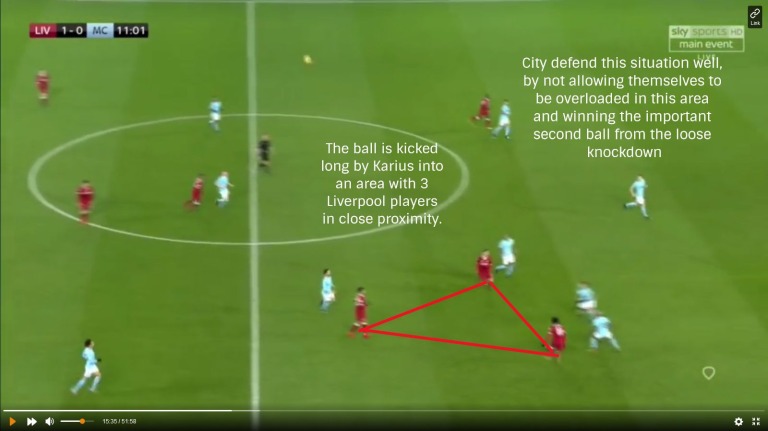
The most successful example of this tactic was Liverpool’s first goal scored by Alex Oxlade-Chamberlain.
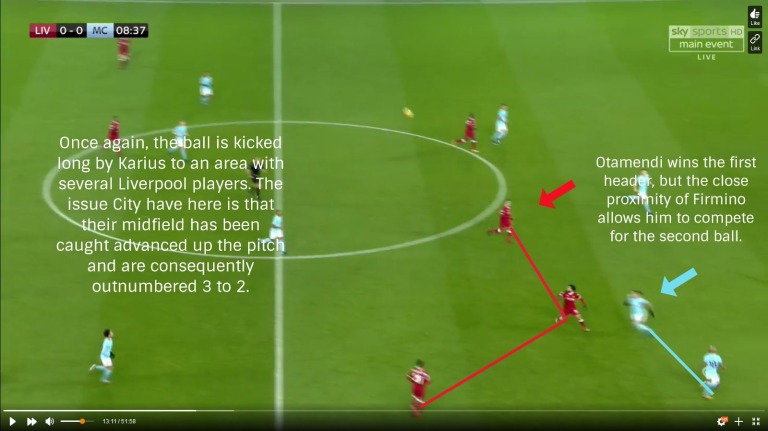
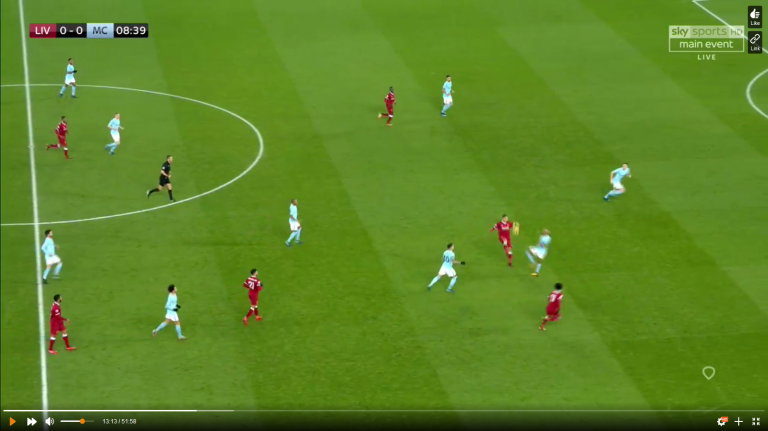
Delph wins the duel with Firmino, but the loose ball drops to Chamberlain, who utilises the space created, drives through and scores a fantastically well struck shot from just outside the area. Liverpool had scored as a consequence of being brave and committing bodies around the ball in an attempt to overload areas and win the ball high up the pitch.
Conclusion
Liverpool’s main tactical focus was to nullify City’s patient build up play from the back. Consequently, the Manchester side found it difficult to get the ball into their dual 8s in dangerous spaces resulting in a display devoid of creative spark. They posted their lowest shots total of the season. Equally, by attacking City’s build up play at source, Liverpool were able to create counter-pressing opportunities and overloads against an isolated City back line who had advanced their midfield and full backs forward during their transition into attack.
The Fernandinho pressing trap choked off his vertical passing options and forced him to play sideways or backwards, providing the trigger for Liverpool to initiate their aggressive press. The resulting turnovers created many good moments, of which the third goal was the most successful example. On the ball, Liverpool went aerially onto their opponents back four in order to bypass City’s own press but also to compete for any resulting knockdowns. Liverpool were brave and held a very high offensive line. This particular strategy was risky as it allowed City to dominate the ball for large periods of the game. However, to counter this, The Reds reverted into a deeper 4-5-1 shape and defended well to limit and stifle City’s creative midfielders, specifically, Kevin de Bruyne. The rewards for such a strategy were clear and perfectly exemplified by Liverpool’s first goal.
Both of these strategies took advantage of Klopp’s desire to counter press and Liverpool’s abundance of energy and tactical intelligence. Manchester City’s transition shape provided the home side with numerous opportunities to exploit an isolated defence. For the most part, Liverpool failed to take advantage of the turnovers they created as City defended very well by collapsing and narrowing their central defence towards the centre of the pitch, forcing Liverpool to go around them and create or shoot from lower percentage positions. However, the efficacy of Liverpool’s quality front line always meant they would eventually break through.
Everything came together for Liverpool in an incredible and high quality ten minutes in the second half, where they completely overwhelmed a clearly shaken Man City with some ‘out of this planet’ pressing and world class finishing. Klopp had tactically out-foxed Guardiola and earned a well deserved victory, ending City’s 30 game undefeated streak and any hopes of an invincible season.
The question is, can Liverpool repeat their performance, or will Guardiola have learnt his lesson and solved the conundrum of Jürgen Klopp and his Liverpool side.
